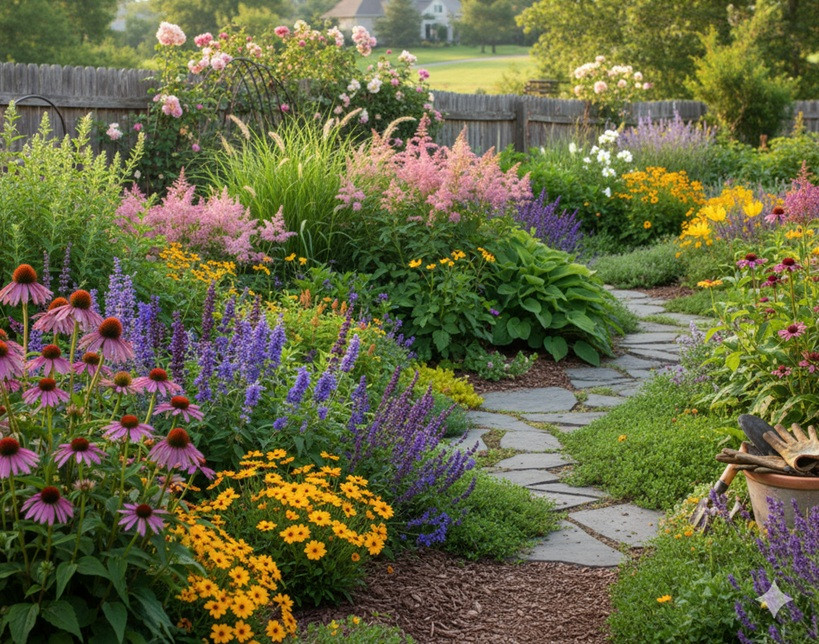Welcome to the world of perennials, where plants return year after year to grace your garden with their beauty. Whether you are a seasoned gardener looking for a new challenge or a beginner just starting your journey, this guide is designed to help you select the perfect perennial plants for your specific needs. From attracting beneficial wildlife to tackling tricky environmental conditions, we have you covered.
Why Choose Perennials?
Perennial plants offer a low-maintenance, long-term solution for your garden. Unlike annuals, which complete their life cycle in one season, perennials establish a strong root system and return each spring, often growing larger and more vigorous over time. This makes them an excellent investment for any gardener.
Attracting Wildlife
Attracts Butterflies: Butterflies are not only beautiful but also crucial pollinators. To create a butterfly haven, choose plants with flat, open flowers that provide easy access to nectar.
- Plant: Butterfly Bush (Buddleia davidii)
- Habit: A fast-growing shrub with long, cone-shaped flower clusters that come in various colors.
- Cultivation: Plant in full sun and well-drained soil. It thrives in warm climates.
- Maintenance: Prune heavily in late winter to encourage new growth and abundant blooms.
- Landscaping Design: Use as a focal point in a border or as a backdrop for smaller perennials.
Attracts Hummingbirds: Hummingbirds are drawn to tubular, brightly colored flowers, especially red and orange.
- Plant: Bee Balm (Monarda didyma)
- Habit: Features unique, whorled flower heads that resemble a shaggy pom-pom.
- Cultivation: Prefers full sun to partial shade and moist, well-drained soil.
- Maintenance: Deadhead spent flowers to prolong the blooming season. Divide clumps every few years to maintain vigor.
- Landscaping Design: Excellent for a cottage garden or a native plant border.
Beneficial for Pollinators: Beyond butterflies and hummingbirds, many plants support bees, and other crucial pollinators.
- Plant: Purple Coneflower (Echinacea purpurea)
- Habit: Daisy-like flowers with a prominent central cone.
- Cultivation: Thrives in full sun and a wide range of soil types, including poor soil. Drought-tolerant once established.
- Maintenance: Low maintenance. Leave seed heads on the plant in the fall to provide food for birds.
Solving Environmental Challenges
Deer Resistant: While no plant is 100% deer-proof, some are less palatable to these herbivores. Deer tend to avoid plants with strong scents, fuzzy leaves, or toxic properties.
- Plant: Lavender (Lavandula spp.)
- Habit: Aromatic, silvery-green foliage with spikes of purple flowers.
- Cultivation: Requires full sun and excellent drainage. Does not tolerate wet feet.
- Maintenance: Prune lightly after flowering to maintain a compact shape.
- Landscaping Design: Ideal for a sunny border, rock garden, or as a low hedge.
Dry Shade Tolerant: Finding plants for dry, shady spots under trees can be a challenge.
- Plant: Barrenwort (Epimedium spp.)
- Habit: Delicate, heart-shaped leaves and wiry stems with tiny, spidery flowers.
- Cultivation: Prefers partial to full shade and tolerates dry soil once established.
- Maintenance: Shear off old foliage in late winter before new growth appears for a tidier look.
- Landscaping Design: A fantastic groundcover for woodland gardens or under large trees.
Hot Dry Site Tolerant: For areas with intense sun and poor, sandy soil, choose tough, resilient plants.
- Plant: Sedum 'Autumn Joy' (Hylotelephium telephium 'Autumn Joy')
- Habit: Upright stems topped with large flower heads that start green, turn pink, and eventually rust-red.
- Cultivation: Requires full sun and well-drained soil. Extremely drought-tolerant.
- Maintenance: Virtually maintenance-free. Provides winter interest with its dried seed heads.
- Landscaping Design: Perfect for rock gardens, xeriscapes, or the front of a sunny border.
Designing with Perennials
Edgers: Use low-growing perennials to create a neat, defined border for a path or garden bed.
- Plant: Lady's Mantle (Alchemilla mollis)
- Habit: Scalloped, soft green leaves that hold water droplets like jewels after a rain. Features frothy, chartreuse flowers.
- Cultivation: Prefers partial shade and moist soil.
- Maintenance: Deadhead to prevent self-seeding.
- Landscaping Design: Creates a beautiful, soft edge along a walkway or in the front of a perennial border.
Groundcovers: These plants spread to cover bare soil, suppressing weeds and preventing erosion.
- Plant: Creeping Phlox (Phlox subulata)
- Habit: A low-growing, mat-forming plant that explodes with a carpet of flowers in spring.
- Cultivation: Requires full sun and well-drained soil.
- Maintenance: Trim back after flowering to encourage dense growth.
- Landscaping Design: Excellent for slopes, rock gardens, or along a path.
Winter Interest: Extend your garden's beauty into the colder months by choosing plants that offer structure, color, or texture in winter.
- Plant: Hellebore (Helleborus orientalis)
- Habit: Leathery, evergreen leaves and nodding, bell-shaped flowers that bloom from late winter to early spring.
- Cultivation: Prefers partial to full shade and rich, well-drained soil.
- Maintenance: Remove old leaves in late winter to showcase the emerging flowers.
- Landscaping Design: Perfect for a shady spot under deciduous trees, where its blooms can be a welcome sight in the early spring.
Success Tips for Perennial Gardening
- Know Your Conditions: Before you buy a single plant, assess your garden's sunlight, soil type, and moisture levels. Right plant, right place is the golden rule of gardening.
- Start Small: Do not try to overhaul your entire garden in one season. Begin with a small border or a single bed and expand as you gain confidence.
- Amend Your Soil: Healthy soil is the foundation of a thriving garden. Add compost or other organic matter to improve soil structure and fertility.
- Mulch, Mulch, Mulch: A 2–3-inch layer of mulch helps retain moisture, suppress weeds, and regulate soil temperature.
- Divide and Conquer: Many perennials benefit from being divided every 3-5 years. This rejuvenates the plant and gives you new plants to share or expand your garden.
By choosing the right perennial for the right spot and providing the proper care, you can create a beautiful, resilient garden that brings joy for years to come. Happy gardening!

